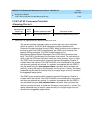
DEFINITY ECS Release 8.2 Maintenance for R8.2csi
555-233-119 Issue 1
April 2000
Maintenance Objects
3-416CUST-ALM (Customer-Provided Alarming Device)
3
CUST-ALM (Customer-Provided
Alarming Device)
The system provides customers a way to connect their own alarm indication
device to a switch. The CUST-ALM maintenance object represents this
Customer-Provided Alarming Device (CPAD). When an alarm occurs at least to
the level to which the CPAD is administered, the CPAD in the Processor Port
Network (PPN)is activated. The CPAD is administered by the
Maintenance-Related System-Parameters Form (CPE Alarm Activation Level
field). The CPAD is connected to the Processor circuit pack. The valid levels to
which to set the CPE Alarm Activation Level are:
none, warning, minor,
or
major.
The CPAD is also activated within a cabinet whenever Emergency Transfer is
invoked within that cabinet. The CUST-ALM MO is not maintained by the system
and does not generate any alarms. If a problem is suspected with the CPAD, it
may be tested using the
test customer-alarm
command, which activates the
device by closing the relay on the Processor circuit pack for 1 minute. The repeat
parameter may be used to close the relay for a longer length of time (5 minutes is
the suggested repeat value).
The CPAD is also activated within a cabinet whenever Emergency Transfer is
invoked within that cabinet. The CUST-ALM MO is not maintained by the system,
and does not generate any alarms. If a problem is suspected with the CPAD, it
may be tested using the
test customer-alarm
command, which activates the
device by closing the relay on either the Processor circuit pack for 1 minute. The
repeat parameter may be used to close the relay for a longer length of time (5
minutes is the suggested repeat value).
MO Name (in
Alarm Log)
Alarm
Level Initial Command to Run
1
1. Where PC is an appropriate port network number and carrier.
Full Name of MO
CUST-ALM none test customer-alarm PC Customer-Provided Alarming Device


















